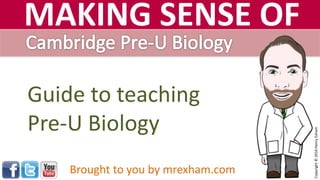
Guide to Cambridge Pre-U Biology
- 1. Guide to teaching Pre-U Biology Brought to you by mrexham.com Copyright©2016HenryExham MAKING SENSE OF
- 2. Copyright © 2015 Henry Exham • This is a two year linear qualification. • The syllabus is divided into six sections. • This is not a teaching order. • Practical work is integral and skills should be developed throughout the two year course. • Much of the course content should be covered independently as this is an important skill to develop. 2
- 3. Copyright © 2015 Henry Exham 3 1. The cell 2. The origin and evolution of life 3. Animal physiology 1.1 Eukaryotic cell structure 1.2 Prokaryotic cells 1.3 Cell replication 1.4 Enzymes 1.5 Respiration 1.6 Genes and protein synthesis 1.7 Applications of cell biology 2.1 The origins of life 2.2 The chemicals of life 2.3 The evolution of life 2.4 Classification 3.1 Transport systems 3.2 Nutrition 3.3 Nerves, muscles and behaviour 3.4 Homeostasis and cell signalling 3.5 The immune system 3.6 Reproduction
- 4. Copyright © 2015 Henry Exham 4 4. The life of plants 5. Environmental studies 6. Practical biology 4.1 Transport in plants 4.2 Photosynthesis 4.3 Reproduction 4.4 Control of plant processes 5.1 Adaptation 5.2 Measuring and conserving biodiversity 6.1 Planning and decision making 6.2 Manipulation, measurement and observation 6.3 Presentation of data and observations 6.4 Analysis of data and conclusions 6.5 Analysis of procedures and data
- 5. Copyright © 2015 Henry Exham • There are four components to the assessment. • Each component is based on the whole syllabus content. • The components are taken together at the end of the course.
- 6. Copyright © 2015 Henry Exham Paper 1 - Structured Paper 2 – Data analysis and planning Paper 4 - PracticalPaper 3 – Case study and synoptic essay 2 hrs 30 min 1 hr 15 min 1 hr 45 min 2 hrs 30 min 40% 15% 22.5% 22.5% • Section A (20 marks) – 20 objective single word answer questions. • Section B (80 marks) – Structured short answer questions. • Section A (35 marks) – Data analysis • Section B (25 marks) – Planning exercise • Section A (30 marks) – Case study • Section B (30 marks) – Synoptic essay – choice from 1 of 3 unstructured questions. • Section A (45 marks) – One or two practical based questions. • Section B (35 marks) – Using a microscope
- 7. Copyright © 2015 Henry Exham A01 Knowledge with understanding (facts, definitions, diagrams, terminology, methodology) 40% A02 Application of knowledge and problem solving (interpret, analyse, evaluate, translate, synthesise, explain, accuracy, validity) 40% A03 Experimental and investigative skills (Plan, report, draw, observe, manipulate, calculate, improve, identify, predict) 20% • Here is a summary of the assessment objectives that the questions will be testing. • As you can see there is a greater than 50% weighting towards the skills element rather than knowledge.
- 8. Copyright © 2015 Henry Exham 1 2 3 Distinction 1 2 3 Merit 1 2 3 Pass
- 9. Copyright © 2015 Henry Exham • Many of the questions will be set in novel contexts and you will need to apply your knowledge and understanding to them. • Therefore it is important to do extensive reading around the syllabus topics and keep up to date with scientific developments in the media.
- 10. Copyright © 2015 Henry Exham • These are just some of the areas of context that may be used: Medicine Veterinary Medicine Agriculture and production Genomics and proteomics History of science Ethics Conservation
- 11. Copyright © 2015 Henry Exham • This is just a basic overview of Pre-U Biology. • Visit this link for the full official specification: http://www.cie.org.uk/programmes-and- qualifications/cambridge-pre-u-biology-9790/
